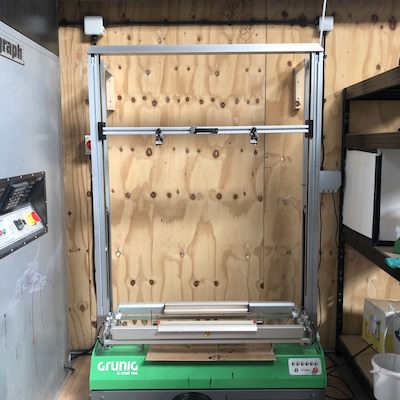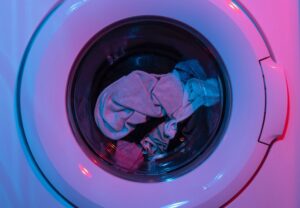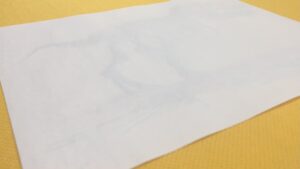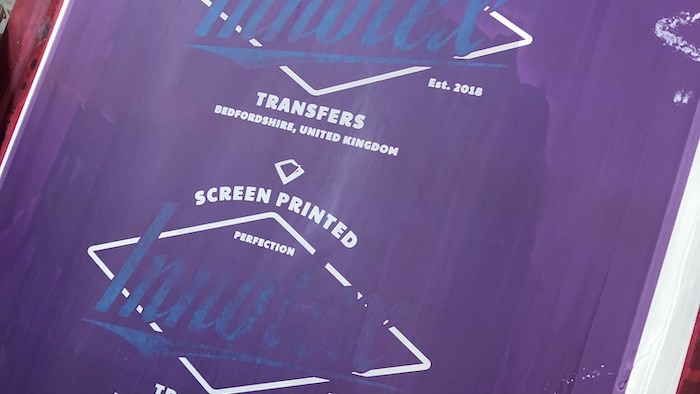Working with screen printing emulsions can be tricky business if you don’t maintain the screens properly. Whether you’ve got multiple jobs to do or you don’t use screens often, this blog is for you! Either way, it’s good to have an understanding of what lack of maintenance and preparation can do. Our blog will cover tips on how to remove screen printing emulsions from screens. If you’re in a pickle and your emulsion is being stubborn, this guide just might do the trick!
What equipment will help me remove screen printing emulsion?
- Emulsion remover
- A squeegee
- Scrub pad
- Water pressure
- Haze remover (optional)
Industry practice of removing screen printing emulsion
Many businesses follow a similar method to remove screen emulsion from their screens, with variations. We’ll cover the standard method before moving on to the best tips to maintain the mesh on your screens.
First things first, we recommend you remove excess ink using a squeegee so you have minimal ink to deal with. Leaving the excess amount on while completing the following steps will only make the job harder and longer.
Have your screen facing horizontally, with the print side up. To remove the emulsion from the screen, you’ll need to slightly wet both sides of the screen. Then, apply an emulsion remover on either side. Let this soak for 20-30 seconds before scrubbing with your scrub pad. As you begin to notice the emulsion wearing down, this is an indicator that it’s time to get the water pressure out. We recommend you give the entire screen a bit of a scrub before immediately moving onto the water pressure. This is because you may have only broken down certain areas. For an even and easy clean, go around the whole surface until you notice a similar breakdown.
NOTE: Do NOT let the emulsion remover dry on the screen. It’s imperative to move on to the next step once it’s had a bit of a soak, or you’ll end up with more problems. Now all you need to do is use a washer pressure to remove the emulsion and the remover chemical. We recommend a pressure of 1000-1500 PSI for optimum removal.
Up to date with your screen printing terminology? Read our blog, Screen Printing Terms You Should Know to find out!
Why isn’t the emulsion coming off?
1) Delay in removing the screen printing emulsions
It’s highly recommended and pretty much a must-do to remove the screen printing emulsion as soon as you can. If you’re not planning to use the screen for a while, it’s good to give it a proper screen clean even if you don’t need it as of yet. If the emulsion for screen printing isn’t removed soon, it can harden. This will cause the emulsion to lock into the screen (which is non-removable). At this point it’ll be pretty much impossible to remove, even with high pressure. The only thing you can do is dispose of the faulty mesh by cutting the screen using a razor or craft knife. However, you can still make use of the screen by getting it re-meshed. Though this doesn’t solve the solution the way you hope, you can make the best of a bad situation.
2) Not using enough emulsion remover
Another reason why emulsion gets stuck on the screen is because you aren’t using enough emulsion remover. You have the option of diluting your concentrated remover, however it isn’t compulsory. Both sides of your screens must be slightly wet before applying the emulsion remover, as this will give it time to soak. Without soaking, the remover won’t do much to break down the emulsion on the mesh.
3) Uneven coating
If the screen printing emulsion isn’t coated evenly in the first place, you may find some areas harder to clean than others. This is down to the excess amount of emulsion that has been applied on the mesh. It’s quite easy to note as the root cause, if the entire screen isn’t suffering from this problem.
When coating your screen, use quick motions across the surface. You may notice that the edges are thicker as the emulsion for screen printing is built up from the swift movement, but this is normal.

Top tips to take away!
- Invest in industry chemicals – too many businesses lose out in the long run by attempting to remove screen printing emulsions using household chemicals. This not only doesn’t work, but it also damages the screens and the mesh may be beyond repair.
- Make the job easier for yourself – take our advice and remove the excess ink as mentioned above. You’ll have less emulsion to work with. This might prevent the ink from needing an excessive amount of elbow grease.
- Get to cleaning right away – Allowing the emulsion to be exposed to UV light will also contribute to the hardening on the mesh. Like we said, this will result in a bigger job to salvage your screen, so don’t step away for a few minutes thinking it’ll do no harm because most likely, it will.
- Use the correct water pressure – the reason we recommend 1000-15000 PSI is because low water pressure won’t get the job done. By the time you realise the pressure is low, the ink and screen printing emulsion remover will only be getting soaked more and you may possibly even dilute the remover too much.
Now that we’ve covered how to clean your screen printing emulsion, whether you’re a new entrant to the market or you’ve been around for a while, Innotex Transfers can provide you with innovative machinery with capabilities of 400 prints an hour! If you’ve got any questions or would like us to do the leg work, get in contact with us!

How to Wash Printed T-shirts: Aftercare Instructions
Previously we’ve covered various topics surrounding printing on t-shirts. Some being avoiding dye migration and even managing the artwork itself before

Transfer Paper For Heat Press Machine
Transfer paper for a heat press machine is vital to ensure your print comes out in high quality, smooth finish.

A Beginner’s Guide to Clothing Labels
Are you a small business owner, or have you always wanted to start your own independent clothing brand? Imagine putting


